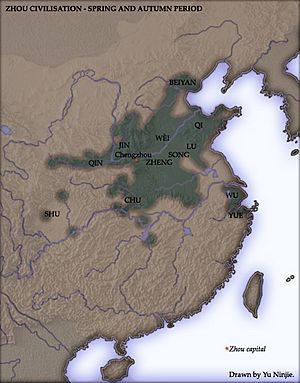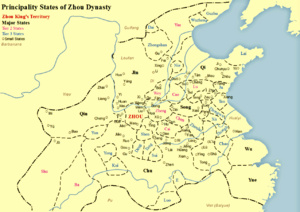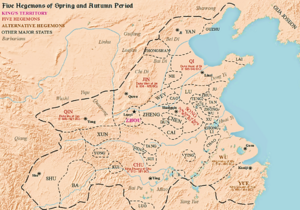Eastern Zhou facts for kids
The Eastern Zhou (Chinese: 東周; pinyin: Dōngzhōu) was the second part of the Zhou dynasty in ancient China. It lasted from 770 BC to 256 BC. This long period is split into two main parts: the Spring and Autumn and the Warring States.
Contents
A New Start: The Eastern Zhou Dynasty
The Eastern Zhou dynasty began when the capital city of the Zhou Kingdom moved. In 770 BCE, the capital moved from Haojing to Luoyi. Luoyi is known today as Luoyang. This move was important because Luoyi was east of the old capital. That's why this new era is called the Eastern Zhou.
More than 25 kings ruled during the Eastern Zhou Dynasty. This period lasted for 515 years. The move happened after King You of Zhou, the last king of the Western Zhou, died. His son, Crown Prince Yijiu, became the new king. He is known as King Ping of Zhou.
King Ping moved the capital east because a group called the Quanrong attacked Haojing. This attack marked the end of the Western Zhou dynasty.
Two Important Periods: Spring and Autumn and Warring States
The first part of the Eastern Zhou was the Spring and Autumn period. It lasted from about 771 BCE to 476 BCE. During this time, the king's power became weaker. Many local rulers, called dukes and marquesses, became very strong. They started to rule their own areas almost like independent kings. They also fought many wars against each other.
The second part was the Warring States period. This period lasted from 475 BCE to 221 BCE. During this time, the King of Zhou had very little power. He was mostly a figurehead, meaning he was a leader in name only. The real power was held by the powerful states fighting for control.
The King's Power Fades
After the capital moved east, the Zhou royal family lost much of its strength. The local rulers, or vassals, grew more powerful. They fought other states and took over more land. Sometimes, they even had to ask these powerful vassals for help.
The most important vassals would meet regularly. They made big decisions together, like going to war against invaders. Sometimes, one of these vassal rulers was called a hegemon. This meant they were the most powerful leader among the vassals.
A smart leader named Guan Zhong of Qi suggested a policy: "Revere the king, expel the barbarians." This meant respecting the Zhou king, but also pushing out foreign invaders. Duke Huan of Qi used this idea to unite the vassals against threats.
Later, during the Warring States period, many vassal leaders even started calling themselves "kings." This made the Zhou royal family's influence even smaller.
Challenges to the King
In 635 BCE, there was a problem called the Chaos of Prince Dai. King Xiang of Zhou had to ask Duke Wen of Jin for help. Duke Wen killed Prince Dai and was given land as a reward. Later, in 632 BCE, Duke Wen of Jin even made King Xiang attend a meeting of vassals. This showed how much power the king had lost.
In 606 BCE, King Zhuang of Chu asked about the "weight of the cauldrons." These cauldrons were symbols of the Zhou king's power. Asking about their weight was a direct challenge to the king. A Zhou minister told him off, but it showed how little respect some rulers had for the king.
By the time King Nan of Zhou ruled, the Zhou kings had almost no political or military power left. Their remaining land was even split into two parts, ruled by different lords. King Nan tried to keep his dynasty going for 59 years using clever talks and plans. But in 256 BCE, he was removed from power and died. Seven years later, the Qin state conquered the last part of the Zhou lands.
Big Changes in Society
The Eastern Zhou period was a time of huge changes in China.
- Iron Age Begins: By the end of this period, iron became the main material for tools. This was the start of the Iron Age in China.
- Farming and Population Growth: Farming methods improved a lot. This led to more food and a bigger population.
- New Money: People started using copper coins for trade.
- Education for Everyone: Education became available to ordinary people, not just nobles.
- Social Changes: The old differences between nobles and common people started to fade away. Society was changing fast, and the old Zhou family system couldn't keep up.
Kings of Eastern Zhou
- King Ping of Zhou — Ji Yijiu (772 BCE–720 BCE)
- King Xie of Zhou — Ji Yuchen (770 BCE–760 BCE or 771 BCE–750 BCE)
- King Huan of Zhou — Ji Lin (719 BCE–697 BCE)
- King Zhuang of Zhou — Ji Tuo (696 BCE–682 BCE)
- King Xi of Zhou — Ji Huqi (681 BCE–677 BCE)
- King Hui of Zhou — Ji Lang (676 BCE–652 BCE)
- King Xiang of Zhou — Ji Zheng (651 BCE–619 BCE)
- King Qing of Zhou — Ji Renchen (618 BCE–613 BCE)
- King Kuang of Zhou — Ji Ban (612 BCE–607 BCE)
- King Ding of Zhou — Ji Yu (606 BCE–586 BCE)
- King Jian of Zhou — Ji Yi (585 BCE–572 BCE)
- King Ling of Zhou — Ji Xiexin (571 BCE–545 BCE)
- King Jing of Zhou — Ji Gui (544 BCE–520 BCE)
- King Dao of Zhou — Ji Meng (520 BCE)
- King Jing of Zhou — Ji Gai (519 BCE–477 BCE)
- King Yuan of Zhou — Ji Ren (476 BCE–469 BCE)
- King Zhending of Zhou — Ji Jie (468 BCE–441 BCE)
- King Ai of Zhou — Ji Quji (441 BCE)
- King Si of Zhou — Ji Shu (441 BCE)
- King Kao of Zhou — Ji Wei (440 BCE–426 BCE)
- King Weilie of Zhou — Ji Wu (425 BCE–402 BCE)
- King An of Zhou — Ji Jiao (401 BCE–376 BCE)
- King Lie of Zhou — Ji Xi (375 BCE–369 BCE)
- King Xian of Zhou — Ji Bian (368 BCE–321 BCE)
- King Shenjing of Zhou — Ji Ding (320 BCE–315 BCE)
- King Nan of Zhou — Ji Yan (314 BCE–256 BCE)
The Spring and Autumn Period: A Time of Change
This period gets its name from a famous book, the Spring and Autumn Annals. This book recorded events in the state of Lu from 722 to 479 BCE. Many people believe Confucius wrote it.
During this time, the Zhou king's power kept shrinking. Local rulers became more independent. They ignored the king's court and fought wars among themselves. The breaking up of the powerful state of Jin marked the end of this period.
The Warring States Period: States Fight for Control
The Warring States period came after the Spring and Autumn period. It was a time when many powerful states fought each other. These wars ended when the state of Qin conquered all the other states. This happened in 221 BCE. Qin then became the first unified Chinese empire, known as the Qin dynasty.
See also
 In Spanish: Dinastía Zhou Oriental para niños
In Spanish: Dinastía Zhou Oriental para niños






